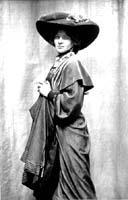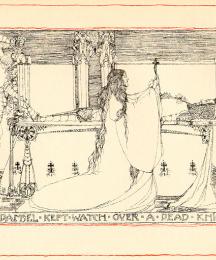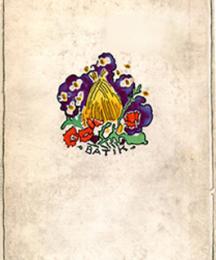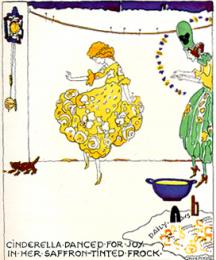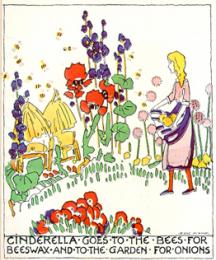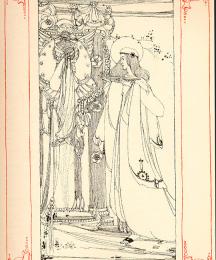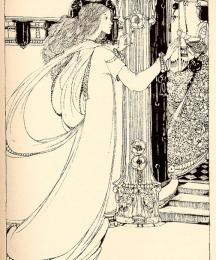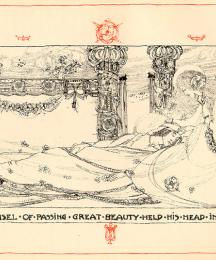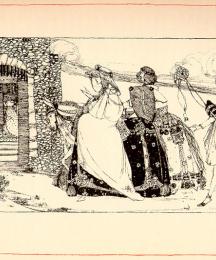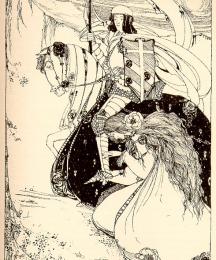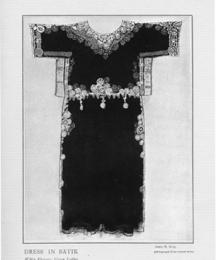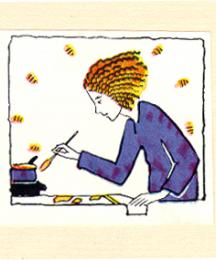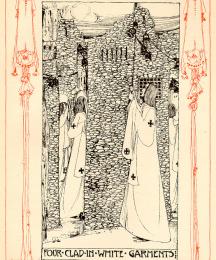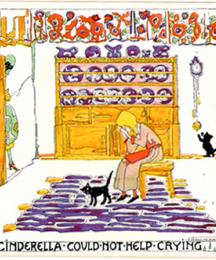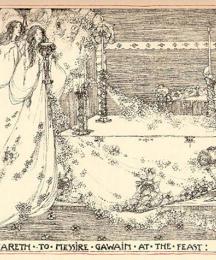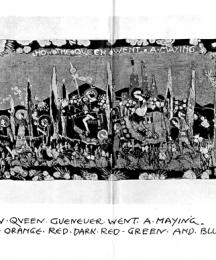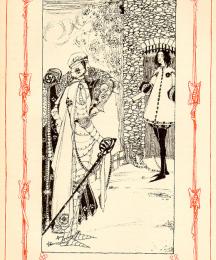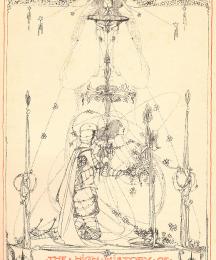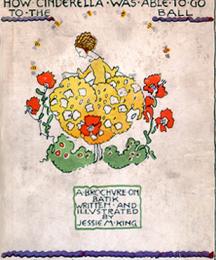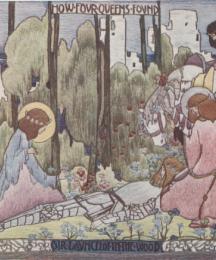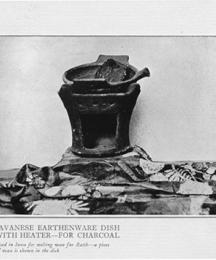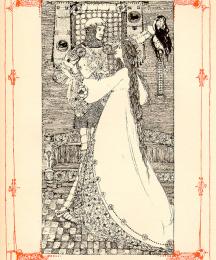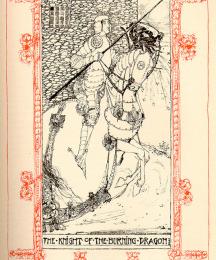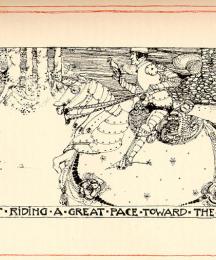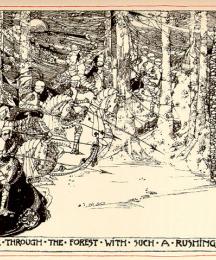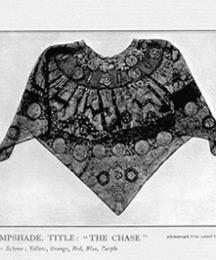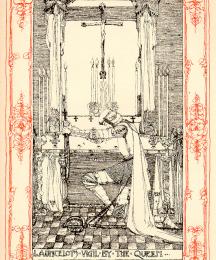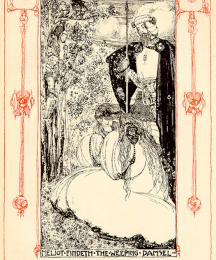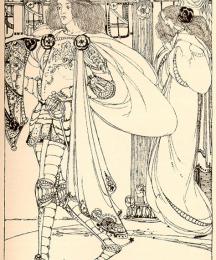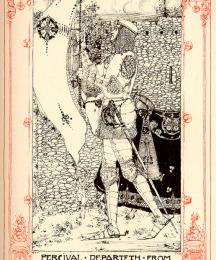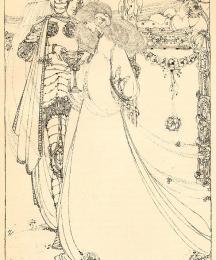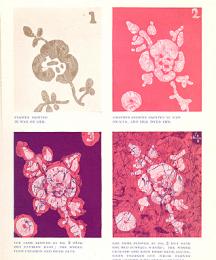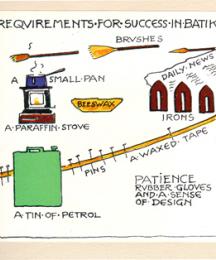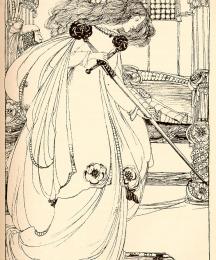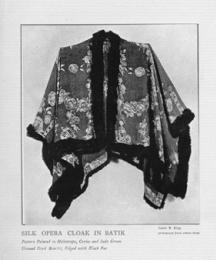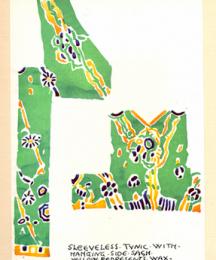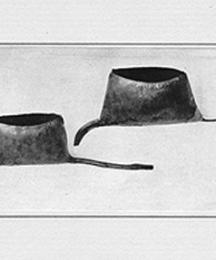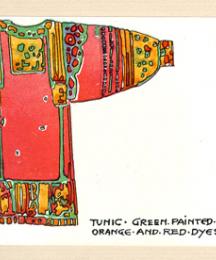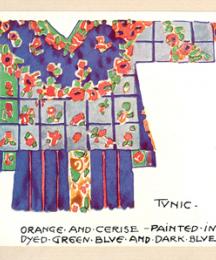Jessie M. King is widely known for her pen and ink lines that follow the art nouveau concepts, but she worked extensively as a muralist, book illustator, and designer of fabric, jewelry, costume and book covers.
Jessie Marion King was born in Bearsden, Scotland, a suburb of Glasgow, on March 20, 1875. Her father, the Reverend James King, was a minister and her mother was the daughter of a banker. The King children numbered five, with four girls, of whom Jessie was the youngest. Their formative years were spent largely in the care of Mary McNab, a housekeeper and governess, whom King came to regard as a second mother.
As part of her formal education, King studied at the Glascow School of Art, which became the center of the uniquely Scottish form of the "Art Noveau" movement that Europe recognized as the "Glascow style." Despite concerns that she was an unsuccessful student, her originality secured her a scholarship to study in France and Italy. In 1898, she won the silver medal in the South Kensington annual competition for her "Light of Asia" drawings. After completing her course in 1899, King taught on a part-time basis at the School and initiated her success as a book illustrator through a series of commissions for German publishers.
In 1902, the first international exhibition of decorative art was held in Turin and King, who earned first prize, established herself as the preeminent book illustrator in the Glascow movement. Her popularity brought additional commissions for cover designs, illustrations, and exhibitions, as well as work in jewelry and fabric design. Among the earlier commissions was her work for Sebastian Evan's translation of the "High History of the Holy Graal", followed
...
Read
More
Read
Less
Jessie M. King is widely known for her pen and ink lines that follow the art nouveau concepts, but she worked extensively as a muralist, book illustator, and designer of fabric, jewelry, costume and book covers.
Jessie Marion King was born in Bearsden, Scotland, a suburb of Glasgow, on March 20, 1875. Her father, the Reverend James King, was a minister and her mother was the daughter of a banker. The King children numbered five, with four girls, of whom Jessie was the youngest. Their formative years were spent largely in the care of Mary McNab, a housekeeper and governess, whom King came to regard as a second mother.
As part of her formal education, King studied at the Glascow School of Art, which became the center of the uniquely Scottish form of the "Art Noveau" movement that Europe recognized as the "Glascow style." Despite concerns that she was an unsuccessful student, her originality secured her a scholarship to study in France and Italy. In 1898, she won the silver medal in the South Kensington annual competition for her "Light of Asia" drawings. After completing her course in 1899, King taught on a part-time basis at the School and initiated her success as a book illustrator through a series of commissions for German publishers.
In 1902, the first international exhibition of decorative art was held in Turin and King, who earned first prize, established herself as the preeminent book illustrator in the Glascow movement. Her popularity brought additional commissions for cover designs, illustrations, and exhibitions, as well as work in jewelry and fabric design. Among the earlier commissions was her work for Sebastian Evan's translation of the "High History of the Holy Graal", followed by a commission to illustrate The Defence of Guenevere by William Morris. During this period King visited the artist E. A. Hornel in Kirkcudbright, Scotland, where she purchased an eighteenth-century home named "Greengate."
In 1908, King married Earnest Archibald Taylor, also a a student and lecturer at the Glascow School, and the couple moved to Salford. The following year, Merle, their first and only child, was born and Mary McNab moved in so that King could continue her career. In 1910, Earnest was offered a position as the Paris correspondent for The Studio and the household moved on to eventually open their own school of art in Paris.
King and Taylor ran the Shealing Atelier for Fine Art in Paris from 1911 to 1913. After tensions accelerated in Europe and war was declared, the couple returned to Kirkcudbright. In the years that followed, the couple became active in charity fund-raising events that allowed them to pursue their interest in theater and costume design. Earnest returned to work in Paris after the war had ended, without re-opening the school; and King worked in applied arts in Kirkcudbright. At this time, she was introduced to the Javanese art form, batik, by an American student named Frank Simmerer. This form inspired her to write and illustrate "How Cinderella Was Able to Go to the Ball" in 1924. Shortly thereafter, King embarked on her work in ceramic decoration, and the couple later worked jointly on a number of decorative murals for different schools.
The onset of World War II hostilities again diminished artistic pursuits, and the Taylor's School remained closed until the war ended. In 1949, King was commissioned to design a cover for "The Parish of New Kilpatrick," the place of her father's ministry. In July of that year, the artist suffered a heart attack and died on August 4th. Her ashes were distributed over the grave of Mary McNab, and those of King's husband were added two years later.
A Chronology of Books Written, Illustrated or Decorated by Jessie M. King
- The Light of Asia, Arnold (1898)
- Jeptha, G. Buchanan (1902)
- The High History of the Holy Graal, trans. by S. Evans (1903)
- The Defence of Guenevere, William Morris (1904)
- Comus, A Masque, John Milton (1906)
- Poems of Spenser, intro by W.B. Yeats, (n.d.)
- A Budding Life: A Book of Drawings (1906)
- Poems of Shelley (1907)
- The Heroes of the Greek Fairy Tales (1907)
- Everyman, A Morality Play, Gowan's & Gray (1907)
- The Legend of Flowers, P. Mantegazza (1908)
- Dwellings of an Old World Town (1909)
- The Grey City of the North (1910)
- The City of the West (1911)
- The Book of Bridges, E. Ancambeau (1911)
- Ponts de Paris, E. Ancambeau (1912)
- Songs and Poems of the Ettrick Shepherd, James Hogg (1912)
- Memories, R.L. Stevenson (1912)
- The Poems of Lindsay Gordon (1913)
- Rubaiyat of Omar Khayyam (1913)
- Isabella and The Pot of Basil, John Keats (1914)
- A House of Pomegranates, Oscar Wilde (1915)
- Our Trees and How to Know Them (1916)
- The Little White Town of Never-Weary (1917)
- Corners of Grey Old Gardens, T.N. Foulis (1917)
- Good King Wenceslas (1919)
- L'Habitation Forcée, Rudyard Kipling (1921)
- Book of Sundials, Launcelot Cross (1922)
- The Grey City of the North - Edinburgh (1922)
- The Interlude of Youth, intro by Hohn Drinkwater (1922)
- How Cinderella Was Able To Go To The Ball (1924)
- Mummy's Bedtime Story Book (1929)
- Whose London (c.1930)
- The Gods Throw Incense, Katharine T. Rae, (1932)
- Our Lady's Garland, Arthur Corder (1934)
- Kirkcudbright: A Royal Burgh (1934)
- The Fringes of Paradise, Florence Drummond (1935)
- Book of Scottish Verse, G. Burnett (1930's)
- The Enchanted Capital of Scotland, I. Steele (1945)
- The Parish of New Kilpatrick, J. McCardel (1949)
- Captain Cook's Voyages, Routledge (n.d.)
- Hans Andersen's Fairy Tales (n.d.)
- The Pilgrim's Progress, John Bunyan (n.d.)
- Wood's Illustrated Natural History (n.d.)
Biography written by: Katherine Marsh
bibliography
Dumfries & Galloway Museums Service. The Greengate Gallery. "Jessie M. King" located at http://www.greengate-gallery.org.uk/jmk.html, 3/29/01.
Houfe, Simon. The Dictionary of 19th Century British Book Illustrators and Caricaturists. Woodbridge, Suffolk: Antique Collectors' Club, 1996.
MacSporran, Archie. "Jessie M. King" located at http://www.archiemacsporran.com/Jessi.htm, 3/29/01.
Peppin, Brigid and Lucy Micklethwait.Book Illustrators of the Twentieth Century. New York: Arco Publishing, Inc., 1984.
Read
Less
